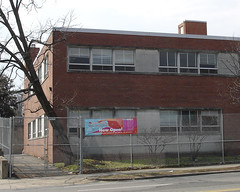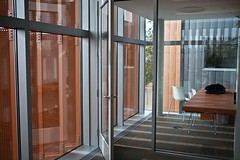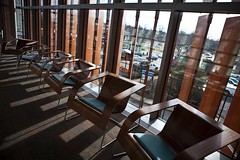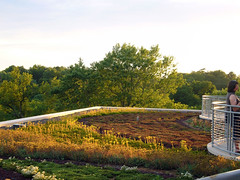Libraries as green community and neighborhood anchors

Posted January 31, 2011 at 1:34PM
Sometime a very long time ago, when I was still new at this smart growth stuff, I remember hearing a planner from Portland recount two principles that had guided one of that city’s famous land use plans: every neighborhood should have a view of Mount Hood, the famous peak not far from the city; and every neighborhood should have a library its residents could walk to. I’ve never been able to locate a planning document that actually says that, but it has stayed with me as a terrific example of thinking about land use in a way that regular people can relate to.
I’m relating to it myself this week because, although there’s no way my east-coast city neighborhood is going to have a view of Mount Hood, it does have a sparkling new library about three blocks’ easy walk from my house. (It also has a splendid view of Washington National Cathedral, a pretty majestic icon in its own right, atop a hill called Mount St. Alban’s.)
I love libraries. When I was a kid you could find me more often than not in one of three places: on a tennis court, somewhere practicing guitar, or in Asheville’s small but elegant downtown library. Like a school, a library gives an anchor to a neighborhood, a sense that it is a neighborhood, worthy of a civic institution, usually with the neighborhood’s name. Ours is called Tenley-Friendship, informally “the Tenley library.”
We had one before, but it was housed in a nondescript 1950s building and, if well used, also well worn. It was time for replacement.  Ideally, the old brick box would have been replaced with a mixed-use building of, say, four or five stories instead of just the two single-use library stories that we have. The mixed-use concept was proposed, but there was the usual wariness from NIMBY neighbors, some complications related to a proposal to take some adjacent property from an elementary school, and a recession that doomed many an ambitious concept. So that part didn’t happen. But kudos to the city for making the new building expansion-ready, as reported by Philip Kennicott in The Washington Post:
Ideally, the old brick box would have been replaced with a mixed-use building of, say, four or five stories instead of just the two single-use library stories that we have. The mixed-use concept was proposed, but there was the usual wariness from NIMBY neighbors, some complications related to a proposal to take some adjacent property from an elementary school, and a recession that doomed many an ambitious concept. So that part didn’t happen. But kudos to the city for making the new building expansion-ready, as reported by Philip Kennicott in The Washington Post:
“Long-standing efforts to develop the site as a mixed-used facility with commercial space never materialized and delayed design and construction. But the new building has been engineered to accommodate a large new neighbor above it. Giant square columns have been relatively well-concealed in the back of the library and could support several floors of new space if the city continues to go forward with intelligent plans to densify the real estate near its Metro stations.”
(The Tenleytown-American University Metro station is nearby.) The building houses 40,000 books and other materials, 32 Mac computers, free Wi-Fi Internet, and a large meeting room for 100.
One of four new DC library branches with sleek new architecture, the Tenley library was designed by the Freelon Group of Durham, North Carolina and, Kennicott notes, creates a “powerful sense that something new has arrived . . . one of the best things to happen to the District, architecturally, in decades.” It also contains at least some spiffy green features, such as exterior window shading that will reduce energy consumption for air conditioning while still cleverly giving users a clean view to the outside. And it has a green roof, too.
Libraries can foster sustainability in multiple ways. Not long ago I was contacted by an organization called the Urban Libraries Council, created four decades ago with a commitment to strengthen the role of libraries as an essential part of urban life, particularly in the inner core of cities. It was, and remains, a direct response to the disinvestment that plagued so many of our older communities in the late 20th century:
“Following several tumultuous years of urban riots in the late 1960s and a growing gap between the wealthy and poor, ULC founders believed the library could uniquely build community, strengthen the local economy, promote civil society and directly enhance lifelong learning and education. The mission of ULC remains the same today.”
The Council’s membership comprises 120 libraries across the US and Canada.
They got in touch because they have a new sustainability report, Partners for the Future: Public Libraries and Local Governments Creating Sustainable Communities. In her introduction, Susan Benton, the group’s CEO, emphasizes three kinds of contributions that libraries can make:
- Engage young children, caregivers and parents in reading readiness programs to support kindergarten success.
- Provide public access computers for under and unemployed citizens needing to submit job applications only accepted online.
- Educate the public on sustainable energy practices and techniques available for home and office.
In its environmental section, the report points out that libraries are ideal candidates for green demonstration projects:
“Every visit to a green public library is a lesson learned about environmental construction and energy efficient operations. Tours of green roofs, kiosks telling the library’s green story, demonstrations of how solar panels on library buildings generate energy, and visible recycling activities raise awareness about the importance of collective community action to preserve environmental resources.”
I am not sure to what extent the the new Tenley branch features green technology and I haven’t yet been inside (it opened last week, and there’s a celebration scheduled for later this week) to see if it takes advantage of teaching opportunities. But green exhibits can be installed at any time. The sooner the better, since the facility's newness is already attracting attention.
The report cites some great examples of other libraries that are seizing an opportunity to showcase the green story, from Fayetteville, Arkansas (above, with green roof, right) to San Francisco to Arlington, Virginia right across the Potomac. In Jacksonville, Florida, there is even a pre-kindergarten reading program that uses environmental themes, coordinated with visits sponsored by the city’s parks department.
I love this, but I would also argue that a successful green agenda need not be explicitly so. An urban library’s greatest contribution to sustainability may well be not its solar panels or green roofs but its symbolic value demonstrating investment in a city neighborhood and its intrinsic value as a place of learning and gathering. When cities, particularly inner cities, are strong, the environment wins, because reinvestment in our older neighborhoods is the antithesis of environmentally damaging suburban sprawl.
In DC, my neighborhood is already strong, but the other three new library branches - on Benning Road in Northeast Washington, on Good Hope Road in Anacostia, and in the Shaw neighborhood – will help these districts continue their recovery from disinvestment.
Kennicott is particularly eloquent in describing how libraries can strengthen community:
“Libraries are rare common ground on the fractious map of democracy, a place where traditional ideas of bootstrap self-improvement meet liberal ideas of open access and equal opportunity. Few encounters with local government - a labyrinth of red tape, taxes, frustration and long lines under fluorescent lights - feel so good as an afternoon in a well-run library. Without lecturing or hectoring or cheap rhetoric, they build consensus and commitment to self-governance.”
There’s not much I need to add to that.
Move your cursor over the images for credit information.





